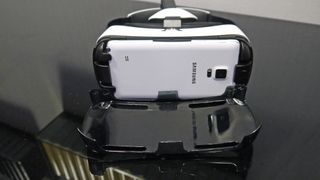Samsung Gear VR has plenty of room for improvement, says its creators
Hint at support for devices other than the Galaxy Note 4

Samsung Gear VR is one of the stranger and more exciting virtual reality prospects set to arrive in the near future, but it's far from perfect.
Thankfully its creators are well aware of this, according to Oculus Vice President of Mobile Max Cohen. Oculus helped Samsung build the Gear VR headset.
At Oculus Connect 2014, the VR conference where the Crescent Bay Oculus Rift prototype made its debut, Cohen said there's a reason the first Gear VR release will be called the "Innovator Edition."
"We're not trying to sell millions of these devices; this is very much for early adopters, tech enthusiasts and developers," he told TechRadar.
Cons…
The Gear VR headset uses a Samsung Galaxy Note 4 to provide users with a portable and versatile virtual reality experience, but "there are some things we can still improve on before we try to sell it to every single person," Cohen said.
"We don't hide from any of the drawbacks," he continued, listing several off: the lack of positional tracking like Oculus Rift has, limited battery life due to the Gear VR's reliance on a phone, and thermal issues that can cause dropped frame rates, to name a few.
"If you run at a high clock rate, then the phone starts to get a little hot," Cohen explained. "It won't actually harm anyone, but it's just shutting down and going to lower clock rates, which can degrade performance enough that you can't hit 60FPS anymore. And if you can't hit 60FPS, you're not going to be in VR. We don't want anyone to be in VR if you're not at frame rate."
Get daily insight, inspiration and deals in your inbox
Get the hottest deals available in your inbox plus news, reviews, opinion, analysis and more from the TechRadar team.
He said Gear VR play sessions will ideally be shorter, in the five- to 20-minute range.
"You can still have engaging things, it's just you're not going to be piloting a space ship for three hours like you would on [Oculus Rift]."
…and pros
But Gear VR is not without its advantages, as well. The Galaxy Note's 5.7-inch 1440p Super AMOLED display looks gorgeous even with your face pressed right up against it, for one, and the iterative nature of phone hardware means the experience could potentially improve every six months or so.
"This is not a Note 4-only product," Cohen teased. "There are lots of other devices that are coming out every six months that we have the opportunity to push hardware and do neat stuff."
And since the Gear VR doesn't need to be connected to a PC like the Rift does, it's naturally more portable. You can swivel around in 360 degrees to your heart's content while you explore a virtual space.
"Being untethered is the biggest thing," Cohen said. "Swivel-chair VR is really going to be I think the ultimate form of consumer VR for a while." Gear VR can also be used more easily while standing up, though Oculus doesn't recommend it, and the lack of positional tracking will hamper that experience.
Cohen said Gear VR is more than just an experiment, and Oculus Rift and Gear VR "are two product lines that we expect to carry on for a while." That means there's plenty of time for improvement as well, and a bright future for virtual reality.
Michael Rougeau is a former freelance news writer for TechRadar. Studying at Goldsmiths, University of London, and Northeastern University, Michael has bylines at Kotaku, 1UP, G4, Complex Magazine, Digital Trends, GamesRadar, GameSpot, IFC, Animal New York, @Gamer, Inside the Magic, Comic Book Resources, Zap2It, TabTimes, GameZone, Cheat Code Central, Gameshark, Gameranx, The Industry, Debonair Mag, Kombo, and others.
Micheal also spent time as the Games Editor for Playboy.com, and was the managing editor at GameSpot before becoming an Animal Care Manager for Wags and Walks.
Most Popular

